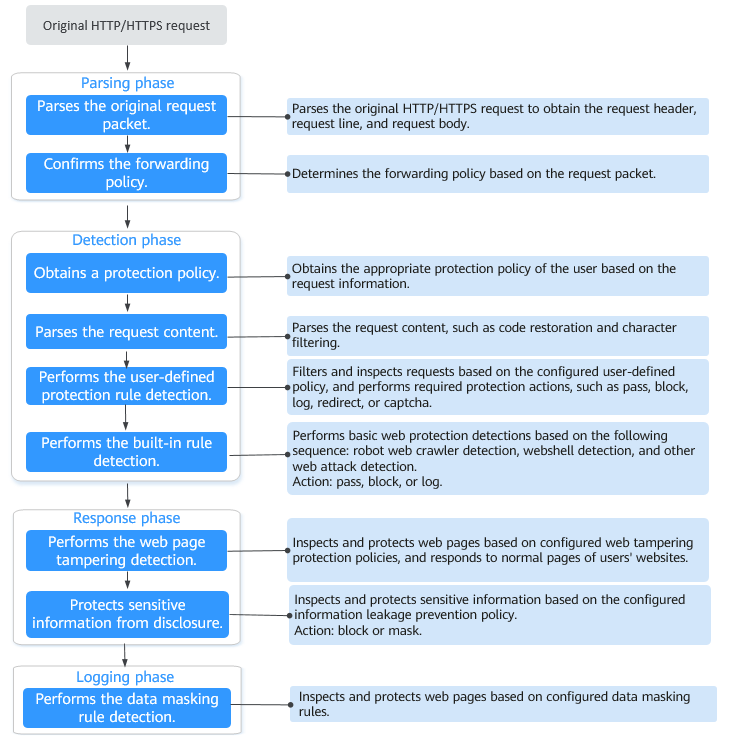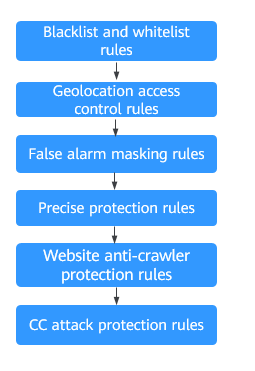Configuration Guidance¶
How WAF Engine Works¶
The built-in protection rules of WAF help you defend against common web application attacks, including XSS attacks, SQL injection, crawlers, and web shells. You can customize protection rules to let WAF better protect your website services using these custom rules. Figure 1 shows how WAF engine built-in protection rules work. Figure 2 shows the detection sequence of user-defined rules.

Figure 1 WAF engine detection process¶

Figure 2 Priorities of custom protection rules¶
Response actions
Pass: The current request is unconditionally permitted after a protection rule is matched.
Block: The current request is blocked after a rule is matched.
CAPTCHA: The system will perform human-machine verification after a rule is matched.
Redirect: The system will notify you to redirect the request after a rule is matched.
Log: Only attack information is recorded after a rule is matched.
Mask: The system will anonymize sensitive information after a rule is matched.
Protection Rule Configuration Methods¶
WAF provides the following customized configuration methods to simplify the configuration process. Select a proper configuration method to meet your service requirements.
Method 1: Configuring protection rules for a single domain name
This method is recommended when you have few domain name services or have different configuration rules for domain name services.
Note
After a domain name is added to WAF, WAF automatically associates a protection policy with the domain name, and protection rules configured for the domain name are also added to the protection policy by default. If there are domain names applicable to the protection policy, you can directly add them to the policy. For details, see Applying a Policy to Your Website.
Where to configure
In the navigation pane, choose Website Settings.
In the Policy column of the row containing the target website, click the number to go to the Policies page.
Protection rules you can configure on the rule configuration page
Table 1 Configurable protection rules¶ Protection Rule
Description
Reference
Basic web protection rules
With an extensive reputation database, WAF defends against Open Web Application Security Project (OWASP) top 10 threats, and detects and blocks threats, such as malicious scanners, IP addresses, and web shells.
CC attack protection rules
CC attack protection rules can be customized to restrict access to a specific URL on your website based on a unique IP address, cookie, or referer field, mitigating CC attacks.
Precise protection rules
You can customize protection rules by combining HTTP headers, cookies, URLs, request parameters, and client IP addresses.
Blacklist and whitelist rules
You can configure blacklist and whitelist rules to block, log only, or allow access requests from specified IP addresses.
Known attack source rules
These rules can block the IP addresses from which blocked malicious requests originate. These rules are dependent on other rules.
Geolocation access control rules
You can customize these rules to allow or block requests from a specific country or region.
Web tamper protection rules
You can configure these rules to prevent a static web page from being tampered with.
Website anti-crawler protection
This function dynamically analyzes website service models and accurately identifies crawler behavior based on data risk control and bot identification systems, such as JS Challenge.
Information leakage prevention rules
You can add two types of information leakage prevention rules.
Sensitive information filtering: prevents disclosure of sensitive information (such as ID numbers, phone numbers, and email addresses).
Response code interception: blocks the specified HTTP status codes.
Global protection whitelist (formerly false alarm masking) rules
You can configure these rules to let WAF ignore certain rules for specific requests.
Configuring a Global Protection Whitelist (Formerly False Alarm Masking) Rule
Data masking rules
You can configure data masking rules to prevent sensitive data such as passwords from being displayed in event logs.
Method 2: Configuring protection rules for multiple domain names
This method is recommended if you have many domain name services and require the same protection policy for multiple domain names. This method greatly reduces repeated configuration workloads and improves the protection efficiency.
Where to configure
In the navigation pane on the left, choose Policies.
Procedure
Add a policy. For details, see Creating a Protection Policy.
Configure protection rules. For details, see Adding Rules to One or More Policies.
Batch add multiple domain names to the policy. For details, see Applying a Policy to Your Website.